NCERT Solutions for Class 12 Micro Economics Production
Class 12 Economics textbook
solutions Micro Economics Chapter-5 Production will give students
an advantage with practical questions. NCERT Solutions provided are easy to
understand and each step in the solution is described to match student
understanding. CBSE Economics For class
12 NCERT Solutions are curated by subject experts and
students can rely on these to score well. NCERT Solutions Economics is prepared
as per the latest CBSE Syllabus and you can use them during your homework or
for your preparation.
Do you want to score high marks in economics in class 12 CBSE board Exams? Then following NCERT Solutions for Class 12 Economics free PDF can help you do it
NCERT
Solutions for Class 12 Economics guides you through this with
utmost precision by offering you easy access to important topics in every
chapter of studyit.in so that you save valuable time right before the exam.
NCERT TEXTBOOK QUESTIONS SOLVED
Question 1. Explain the concept of a production function. [CBSE 2004C, 07, 09C; AI 05, 08, 11] [1 Mark]
Answer: The relationship between physical input and physical output of a firm is generally referred to as production function.
The general form of production
function is, q = f (x1 : x2)
where, q = output, x1 = 1 input like labour, x2 = another input like machinery
Question 2. What is the total product of an input? [ 1 Mark]
Answer: Total product of an input refers to total volume of goods and services produced by a firm with the given inputs during a specified period of time.
Question 3. What is the average product of an input? [AI 2013,Q] [1 Mark]
Answer: Average Product of am input is per unit product of variable factors. It is calculated by dividing the total Product by the units of variable factor.
Average Product =
Question 4. ‘What is the marginal product of an input? [AI 2005, 13C; 07; CBSE 2005, 06, 06C] [1 Mark]
Answer: Marginal Product of an input is an addition to the total product when an additional unit of a variable factor is employed.
Question 5. Explain the relationship between the marginal products and the total product of an input.
Or [AI 05, 07; CBSE 05, 06, 07] Explain the law of variable proportion with the help of total product and marginal product curves.
[CBSE 2010, 2013] Or
Explain the likely behaviour of Total Product and Marginal Product when for increasing production only one input is increased while all other inputs are kept constant.
[CBSE Sample Paper 2010] [6 Marks] Or
State the different phases of changes in Total Product and Marginal Product in the Law of Variable Proportions. Also show the same in a single diagram. [CBSE 2015]
Answer: According to the Law of Variable Proportion when only one input is increased while all other inputs are kept constant, Marginal Product and Total Product behave in the following manner:
- When Marginal product rises (till Point P1), Total product increases at an increasing rate (convex shape) (till point P).
- When Marginal product falls and remains positive (Till point B1), total product increases at a diminishing rate (concave shape) (till point A),
- When Marginal Product is zero (at point B1), Total Product is at its maximum and constant (At point B),
- When Marginal product becomes negative (after point B1), total product falls (after point B).
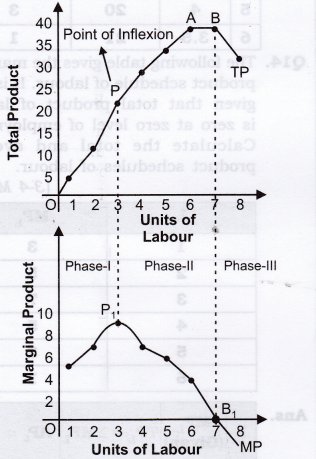
Question 6. Explain the concepts of the short run and the long run. [3-4 Marks]
Answer:
- Short run:
(a) A short run refers to the period of time in which a firm cannot change some of its factors like plant, machinery, building, etc. due to insufficiency of time but can change any variable factor like labour, raw material, etc.
(b) Thus, in short run, there will be some factors of production that are fixed at predetermined levels, e.g., a farmer may have fixed amount of land, - Long run:
(a) A long run is a time period during which a firm can change all its factors of production including machines, building, organization, etc.
(b) In other words, it is a period of time during which supplies can adjust itself to change in demand.
Note:
(i) Mind, here the terms long run and short run are functional and do not refer to a calendar month or a year,
(ii) This distinction depends merely upon how quickly factor inputs can be change by producers in an industry.
Question 7. What is the law of diminishing marginal product? [I Mark]
Answer: The Law of diminishing marginal product states that when we applied more and more units of variable factor to a given quantity of fixed factor, total product increases at a diminishing rate and marginal product falls.
Question 8. What is the law of variable proportions?
Or
Define the law of variable proportion. [CBSE 2004, 06[[1 Mark]
Answer: The law of variable proportion states that as we increase the quantity of only one input, keeping other inputs fixed, the total product increases at an increasing rate in the beginning, then increases at decreasing rate and after a level the output ultimately falls.
Question 9. The following table gives the total product schedule of labour. Find the corresponding average product and marginal product schedules of labour. [3-4 Marks]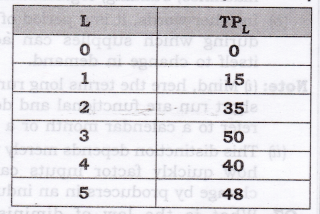
Answer: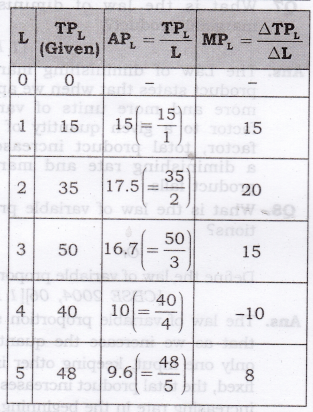
Question 10. The following table gives the average product schedule of labour. Find the total product and marginal product schedules. It is given that the total product is zero at zero level of labour employment. [3-4 Marks]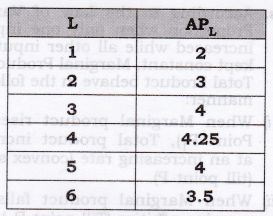
Answer: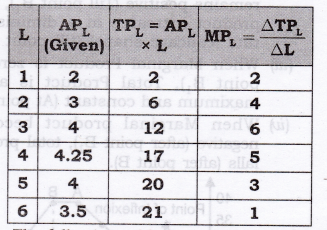
Question 11. The following table gives the marginal product schedule of labour. It is also given that total product of labour is zero at zero level of employment. Calculate the total and average product schedules of labour. [3-4 Marks]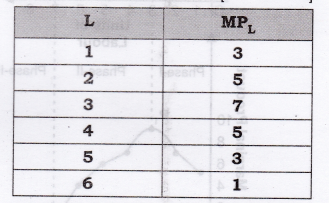
Answer: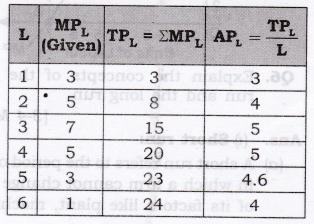
Question 12. Let the production function of a firm be
Answer:
Q = 5 x 10 x 10 = 500 units So, the maximum possible output(Q) = 500 units.
MORE QUESTIONS SOLVED
I. Very Short Answer Type Questions (1 Mark)
Question 1. Give the meaning of production function. [CBSE 2007, AI 2011] Or
Define production function. [CBSE Sample Paper 2008]
Answer: The relationship between physical input and physical output of a firm is generally referred to as production function.
Question 2. In which run some factors of production are fixed and others are variable?
Answer: Short run.
Question 3. What change will take place in marginal product when total product increases at a diminishing rate? [CBSE Sample Paper 2010]
Answer: Marginal product will decline but remains positive.
Question 4. In which phase of Law of Variable Proportions a rational firm aims to operate?
Answer: Diminishing returns to a factor (Phase 2).
Question 5. What is meant by diminishing returns to a factor?
Answer: Diminishing returns to a factor refer to a phase when total product increases at a decreasing rate and marginal product falls, but remains positive with the increase in variable factor.
Question 6. What is the general shape of the AP and MP curves?
Answer: AP and MP curves are inversely U-shaped.
Question 7. How does fall in marginal production affect total output?
Answer: Fall in marginal product affects the total output in the following two manners:
- When marginal product falls, but remains positive, total product increases at a diminishing rate.
- When marginal product falls and become zero, total product falls in its absolute terms.
Question 8. Why MP curve cuts AP curve at its maximum point?
Answer: It happens because when AP rises, MP is more than AP. When AP falls, MP is less than AP. So, it is only when AP is constant and at its maximum point that MP is equal to AP. Therefore, MP curve cuts AP curve at its maximum point.
Question 9. Can AP rise when MP starts declining?
Answer: Yes, AP can rise when MP starts declining. It can happen as long as falling MP is more than AP. However, when MP becomes equal to AP, further decline in MP will also reduce AP.
Question 10. What is the shape of AP and MP?
Answer: Inverse U-Shaped.
Question 11. Give meaning of “Return to a Factor”. [CBSE 2013Q]
Answer: Return to a factor states that change in the physical output of a good when only the quantity of one input is increased, while that of other input is kept constant.
II. Multiple Choice Questions (1 Mark)
Question 1. The marginal product of a variable input is best described as:
(a) Total product divided by the number of units of variable input.
(b) The additional output resulting from one unit increase in the variable input.
(c) The additional output resulting from one unit increase in both the variable and fixed inputs.
(d) The ratio of the amount of the variable input that is being used to the amount of the fixed input that is being used.
Answer: (b)
Question 2. Diminishing marginal returns implies:
(a) Decreasing average variable costs.
(b) Decreasing marginal costs.
(c) Increasing marginal costs.
(d) Decreasing average fixed costs.
Answer: (c)
Question 3. The short run, as economists use the phrase, is characterized by:
(a) At least one fixed factor of production and firms neither leaving nor entering the industry.
(b) A period where the law of diminishing returns does not hold.
(c) No variable inputs that is all the factors of production are fixed.
(d) All inputs being variable.
Answer: (a)
Question 4. The marginal, average, and total product curves encountered by the firm producing in the short run exhibit all of the following relationships except:
(a) When total product is rising, average and marginal product may be either rising or falling.
(b) When marginal product is negative, total product and average product are falling.
(c) When average product is at its maximum, marginal product equals average product, and total product is rising.
(d) When marginal product is at a maximum, average product equals marginal product, and total product is rising.
Answer: (d)
Question 5. To economists, the main difference between short run and long run is that:
(a) In short run all inputs are fixed, while in long run all inputs are variable.
(b) In short run the firm varies all of its inputs to find the least cost combination of inputs.
(c) In short run, at least one of the firm’s input level is fixed.
(d) In long run, the firm is making a constrained decision about how to use existing plant and equipment efficiently.
Answer: (c)
Question 6. Which one of the following statements is the best definition of production function?
(a) The relationship between market price and quantity supplied.
(b) The relationship between the firm’s total revenue and the cost of production.
(c) The relationship between the quantities of inputs needed to produce a given level of output.
(d) The relationship between the quantity of inputs and the firm’s marginal cost of production.
Answer: (c)
Question 7. Diminishing returns occur:
(a) When units of a variable input are added to a fixed input and total product falls.
(b) When units of a variable input are added to a fixed input and marginal product falls.
(c) When the size of the plant is increased in the long run.
(d) When the quantity of the fixed input, is increased and returns to the variable input falls.
Answer: (b)
Question 8. If the marginal product of labour is below the average product of labour, it must be true that:
(a) The marginal product of labour is negative.
(b) The marginal product of labour is zero.
(c) The average product of labour is falling.
(d) The average product of labour is negative.
Answer: (c)
Question 9. The average product of labour is maximized when marginal product of labour:
(a) Equals the average product of labour.
(b) Equals zero.
(c) Is maximized.
(d) None of these.
Answer: (a)
Question 10. The law of variable proportions is drawn under all of the assumptions mentioned below except the assumption that:
(a) The technology is changing.
(b) There must be some inputs whose quantity is kept fixed.
(c) We consider only physical inputs and not economically profitability in monetary terms.
(d) The technology is given and stable.
Answer: (a)
Question 11. Average product is defined as:
(a) Total product divided by the total cost.
(fa) Total product divided by the marginal product.
(c) Total product divided by the variable input.
(d) Marginal product divided by the variable input.
Answer: (c)
Question 12. The change in the total product resulting from a change in a variable input is:
(a) Average cost (b) Average product
(c) Marginal cost (d) Marginal product
Answer: (d)
Question 13. Marginal product, mathematically, is the slope of the
(a) Total product curve
(b) Average product curve
(c) Marginal product curve
(d) Implicit product curve
Answer.(a)
Question 14. Diminishing marginal returns for the first four units of a variable input is exhibited by the total product sequence:
(a) 50, 50, 50, 50
(b) 50, 110, 180, 260
(c) 50, 100, 150, 200
(d) 50, 90, 120, 140
Answer: (d)
III. Short Answer Type Questions (3-4 Marks)
Question 1. Differentiate between Short Period and Long Period.
Answer:
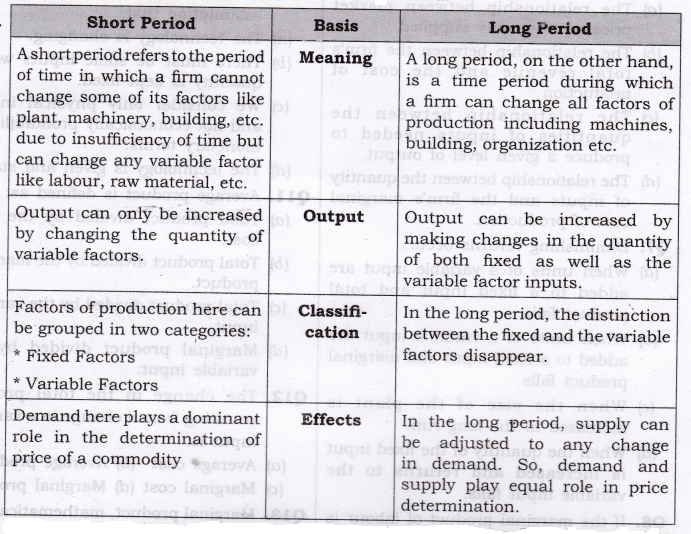
Question 2. Differentiate between Short Period production and Long Period production function.
Answer: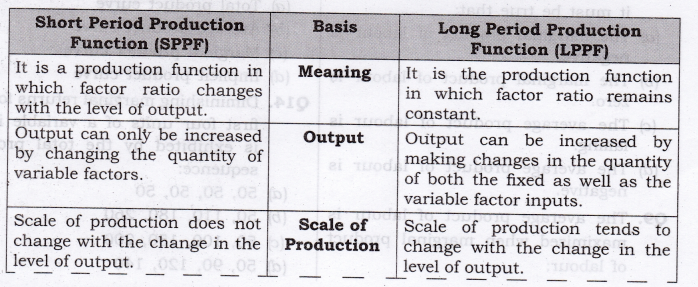
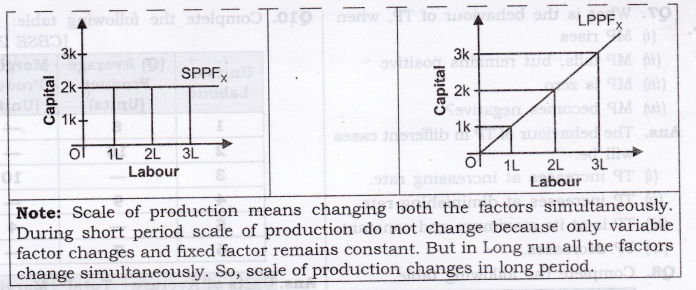
Question 3. Explain the relationship between Marginal product and Average Product. Or [CBSE 2012 C]
State the relation between Marginal product and average product. Use diagram. [AI 2013C]
Answer:
- Average Product increases as long as Marginal Product (MP) > Average Product (AP). Alternatively, when MP > AP, AP rises.
- Average Product is maximum and constant when Average Product (AP) = Marginal Product (MP). Alternatively, when AP = MP, AP is maximum.
- Average Product falls when Marginal Product < Average product.
- Marginal Product can be zero and negative but Average product is never zero.
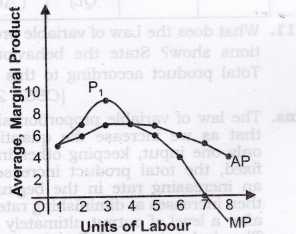
Question 4. Explain the relationship between Total Product and Average Product.
Answer:
- When Total Product increases at an increasing rate, Average Product also increases.
- When Total Product increases at a diminishing rate, Average Product declines.
- Since Total Product is always positive, Average Product also remains throughout positive.
Question 5. Explain the relationship between Total Product, Average Product and Marginal Product.
Answer:
- In the beginning Total Product, Average Product and Marginal Product all increase, but Marginal Product > Average Product and Total Product > Marginal Product.
- When Marginal Product = 0, Total Product is maximum and constant and Average Product is decreasing.
- Thereafter, both Average Product and Marginal Product continue to decline, but Marginal Product < Average Product and Total Product declines at an absolute term.
- Marginal Product can be zero and negative but Average Product and Total Product can never be zero.
Question 6. What is the reaction of AP, when:
- MP is more than AP.
- MP is less than AP.
- MP is equal to AP.
Answer: The reaction of AP in different cases will be:
- AP will rise.
- AP will fall but it will remain positive.
- AP will be constant and at its maximum point.
Question 7. What is the behaviour of TP, when
- MP rises
- MP fails, but remains positive
- MP is zero
- MP becomes negative?
Answer: The behaviour of TP in different cases will be:
- TP increases at increasing rate.
- TP increases at diminishing rate,
- TP is at its maximum and constant.
- TP decreases.
Question 8 . Complete the following table.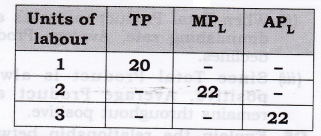
Answer: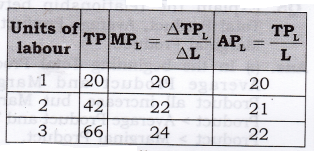
Question 9. Complete the following table.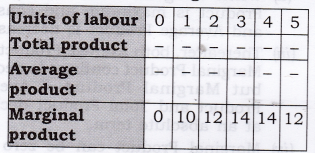
Answer: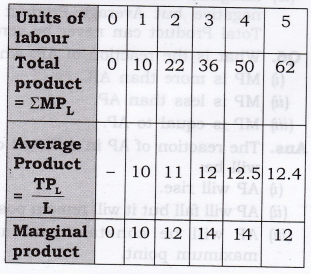
Question 10. Complete the following table: [CBSE 2013]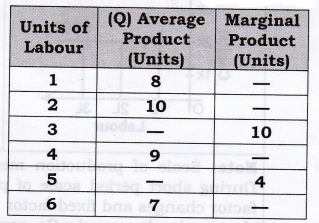
Answer: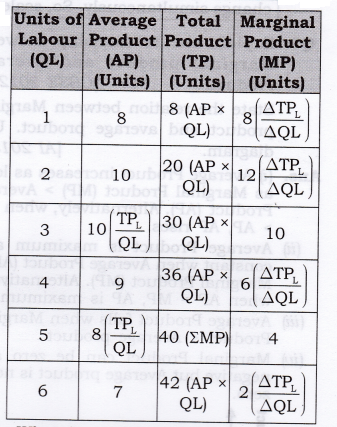
Question 11. What does the Law of variable proportions show? State the behaviour of Total product according to this Law. [CBSE 2012]
Answer: The law of variable proportion shows that as we increase the quantity of only one input, keeping other inputs fixed, the total product increases at an increasing rate in the beginning, then increases at diminishing rate and after a level of output ultimately falls. The behaviour of Total product according to this law is as under:
- TP increases continuously from points O to A.
- It increases at an increasing rate (convex shape) from O to P and at a diminishing rate (concave shape) from P to A.
- TP is maximum at A and remains so up to point B.
- After Point B, Total Product falls.
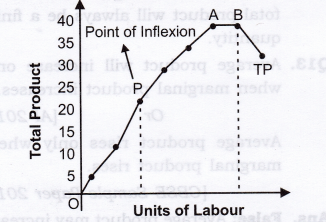
Question 12. Complete the following table: [CBSE Sample Paper 2016]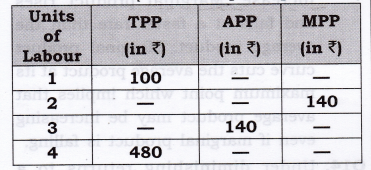
Answer: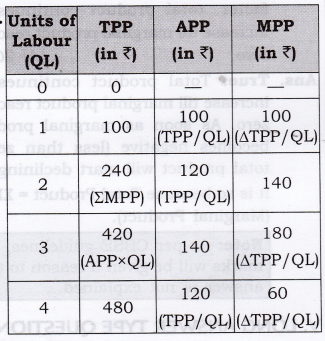
IV. True Or False
Giving reasons, state whether the following statements are true or false.
Question 1. When the quantity of a variable input is increased from 3 units to 4 units, the total output increases from 70 units to 85 units. The marginal product of the variable input is 15 units.
Answer: True: Marginal product of a variable input is an addition to total output due to one unit increase in variable input. Hence marginal product is 15/1 = 15.
Question 2. When the quantity of a variable input is increased from 4 to 6 units, the total output increases from 85 units to 105 units. The marginal product of the variable input is 20 units.
Answer: False: Marginal product is addition to the total output due to the increase in one unit variable input. Here, total output increases by 20 units due to two units increase in variable input. Hence, marginal product is 20/2 = 10 units.
Question 3. When the marginal product of a variable input falls, total product also falls.
Answer: False: Total product is defined as:
TP = MP1 + MP2 + + MPn.
Thus, as long as MP is more than zero, TP keeps increasing at a diminishing rate, although MP may be diminishing.
Question 4. When there are diminishing returns to a factor, total product always decreases. [CBSE 2009]
Answer: False: This is because when there are diminishing return to factor, then total product increase at diminishing rate.
Question 5. Total product will increase only when marginal product increases. [CBSE 2009]
Answer: False: Total product will also increase when marginal product decreases and when marginal product decreases, the total product increases at diminishing rate.
Question 6. Increase in total product always indicates that there are increasing returns to a factor. [CBSE 2009]
Answer: False: It is not necessary that the increase in total product always indicates that there are increasing returns to factor because when there are diminishing returns to factor, then also total product increases but at a diminishing rate.
Question 7. When there are diminishing returns to a factor, marginal and total product both always fall. [CBSE 2009]
Answer: False: It is so because when there are diminishing returns to factor, only marginal product tends to fall and total product tends to increase at a diminishing rate.
Question 8. When there are diminishing returns to a factor, total product first increases and then starts falling. [AI 2009, 010]
Answer: False: As when there is diminishing returns to a factor, total product increases at diminishing rate and never falls during diminishing returns. .
Question 9. Total product always increases whether there is increasing returns or diminishing returns to a factor. [ CBSE, AI 2010]
Answer: True: As when there is increasing return, total product increases at increasing rate and when there are diminishing returns, total product increases at a diminishing rate.
Question 10. If marginal product rises, average product must also rise.
Answer: True: Rising of marginal product implies that the total product increases at an increasing rate. This pulls up the average product also.
Question 11. If marginal product falls, average product must also fall. [CBSE 2010]
Answer: False: There may be an intermediate stage when the marginal product may be falling, the average product keeps rising or constant. This occurs when the fixed inputs are better utilised.
Question 12. If marginal product becomes negative, average product must also become negative.
Answer: False: Marginal product can be negative. But the average product can never be negative, because total product will always be a finite quantity.
Question 13. Average product will increase only when marginal product increases.
Or [AI 2013]
Average product rises only where marginal product rises.
[CBSE Sample Paper 2014]
Answer: False: Average product may increase even if marginal product does not increase. Marginal product rises and falls at a faster rate than the average product. Marginal product curve cuts the average product at its maximum point which implies that average product may be increasing even if marginal product is falling.
Question 14. Under diminishing returns to a factor, total product continues to increase till marginal product reaches zero. [AI 2013]
Answer: True: Total product continues to increase till marginal product reaches zero. As soon as marginal product becomes negative (less than zero), total product will start declining.
It is so because Total Product = ΣMPL, (Marginal Product).
Note: As per CBSE guidelines, no marks will be given if reason to the answer is not explained.
V. Long Answer Type Questions (6 Marks)
Question 1. State the behaviour of marginal product in the law of variable proportions. Explain the causes of this behaviour. [CBSE 2014]
Or
Giving reasons, explain the law of variable proportion. [AI.2014]
Or
What are the different phases in the Law of Variable Proportions in terms of marginal product? Give reason behind each phase. Use diagram. [AI 2015]
Answer: The behaviour of Marginal product in the law of variable proportion is as under:
- When Marginal product rises (till Point P1), Total product increases at an increasing rate (convex shape) (till point P).
- When Marginal product falls and remains positive (Till point B1), total product increases at a diminishing rate (concave shape) (till point A),
- When Marginal Product is zero (at point B1), Total Product is at its maximum and constant (At point B).
- When Marginal product becomes negative (after point B1), total product falls (after point B).
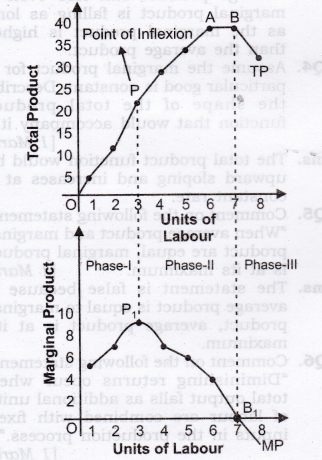
Causes or Reasons of this Behaviour is as Under:
- Phase I
(a) Proper utilization of the fixed factor
• In the initial stage of production the units of variable input (i.e., labour) is so less that fixed inputs cannot be effectively utilized.
• Proper utilization of the fixed factor can be attained when more and more units of variable factor (labour units) are applied to the fixed factor (land), the fixed factor will be used intensively and output will increase rapidly.
(b) Specialization and division of labour
• Initially there was only one labour working on all the 5 acres of land ploughing, watering, etc.
• As the number of labour units increases, each worker specialized in a particular activity leads to specialization of the variable units and this resulted in increased output. - Phase II
(a) The non-optimal combination of variable factor with the fixed factor
• When a given quantity of a fixed factor is combined with more and more units of variable factor, the additional units of variable factor will have smaller and smaller quantity of fixed factor to work with them.
• As many workers share the same fixed factor, the share of each would obviously fall. Therefore, the cooperation of the fixed factor is not available to the same extent. Thus, an increase in the variable factor would add less and less to total output.
(b) Imperfect Substitutes
• Diminishing return to factor occurs because variable factor and fixed factor are imperfect substitutes to each other.
• Technically speaking, there is a limit to which variable factor can be applied to fixed factor and that limit depends upon the efficiency of fixed factor. So, variable factor and fixed factor are imperfect substitutes to each other. - Phase III
(a) Efficiency of Variable Factor Fall
• In this stage the amount of variable factor becomes excessive relative to the fixed factor. This happens when too many LABOUR are engaged in cultivating on a given piece of land.
• Instead of helping each other in production they cause overcrowding and chaos and thus hamper each other’s work. In such a case, the contribution of additional labour to production is bound to be negative.
• Thus, the marginal returns become negative and the total returns start diminishing.
(b) Efficiency of Fixed Factor Fall
• Too much of a variable factors may also lead to the inefficiency of the fixed factor as well.
• In case of capital-, which is a fixed factor, too much of labour may cause lot of wear and tear of machinery, frequent breakdowns and excessive cost of maintenance. This is bound to affect total production adversely.
• In such a situation it is advisable to reduce the units of the variable factor than to increase it with a view for getting maximum production.
VI. Higher Order Thinking Skills
Question 1. If diminishing marginal returns will set in after the very first unit of labour is employed? What do the average product, and marginal product curves look like in this case? [3-4 Marks]
Answer: The marginal and average product curves will fall because diminishing marginal returns means that total product increases at diminishing rate that makes the average and marginal product to fall. It can be explained with the help of the given diagram.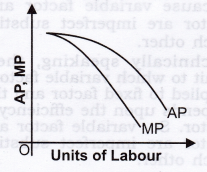
Question 2. Explain the differences between variable factors and fixed factors. [3-4 Marks]
Answer: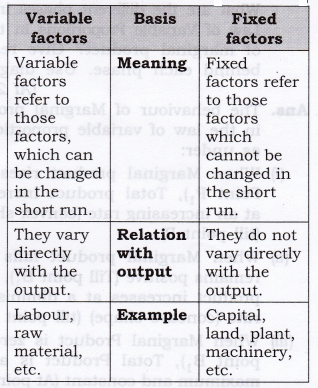
Question 3. Explain how is it possible for marginal product to fall while average product is rising? [1 Mark]
Answer: Average product can rise even if marginal product is falling as long as the marginal product is higher than the average product.
Question 4. Assume the marginal product for a particular good is constant. Describe the shape of the total product function that would accompany it. [1 Mark]
Answer: The total product function would be upward sloping and increases at a constant rate.
Question 5. Comment on the following statement: “When average product and marginal product are equal, marginal product is at its maximum.” [1 Mark]
Answer: The statement is false because if average product is equal to marginal product, average product is at its maximum.
Question 6. Comment on the following statement: “Diminishing returns occur when total output falls as additional units of labour are combined with fixed inputs in the production process.” [I Mark]
Answer: The statement is false because diminishing returns occur when marginal product falls as additional units of labour are combined with fixed inputs in the production process.
VII. Value Based Questions
Question 1. A farmer in Punjab transports wheat from the farm to a flour mill. Is this activity considered as production? Why? [ 1 Mark]
Answer: Yes, It adds to the utility and generates income.
Value: Critical thinking
Question 2. How can the productivity of Human resources be increased? [1 Mark]
Answer: The productivity of human resource can be increased with the help of human capital formation by providing training and skill to available labour force.
Value: Creative thinking.
Question 3. Availability of agricultural land (fixed factor) is limited in the world, but demand of food grain is continuously increasing. Is it possible to increase the supply of food grains by continuously increasing variable factors like seeds, fertilizers etc.? [1 Mark]
Answer: Availability of agricultural land is limited in the world, production of food grains may be increased by continuous increase in variable factors only up to a optimum combination with fixed factor. After that law of negative returns is applied.
Value: Critical thinking
Question 4. Though the contribution of plastic industry in GDP is more, yet why is it not considered an Index of social welfare? [ 1 Mark]
Answer: Because in the production of plastic product a lot of harmful gases are released in the atmosphere.
Value: Environment conservation
Question 5. Which one of the following will be treated as labour in economics? Give a reason for each.
- Preparation of food by a housewife.
- Singing for one’s own pleasure.
- Driving his master’s car by a driver.
- Playing cricket by Virat Kohli. [3-4 Marks]
Answer: (1) and (2) do not generate any income.
(3) and (4) constitute labour. These generate income.
Value: Critical thinking
Question 6. What efforts should be made in an economy for the continuous use of exhaustible natural resources in production? [3-4 Marks]
Answer: There are various efforts; namely,
- To increase use of renewable resources
- To explore the substitutes of resources
- To reduce the wastage of resources.
- To spread awareness about the effectively and optimum use of natural resources.
Value: Environmental conservation
VIII. Application Based Questions
Question 1. The data below shows the relationship between total output and the amount of labour hired at Papa’s Pizza Shop—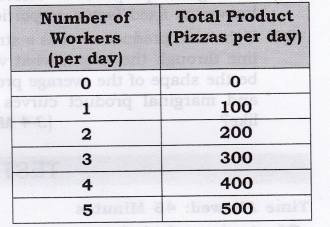
Does the production function in the above table exhibit diminishing marginal returns? Explain. [3 Marks]
Answer: No, the production function does not exhibit diminishing marginal returns. As the amount of labour hired increases, the marginal product of labour is constant. This violates the law of diminishing marginal returns.
Question 2. Give reasons for the following statements:
- Variable factor proportions obtain in the short run.
- Fixed factor proportions obtain in the long run. [3-4 Marks]
Answer:
- Short run is a period of time in which some factors are variable, and at least one factor is fixed. The level of output in a firm can be increased only by increasing the quantity of variable factors. The quantity of fixed input remains unchanged at different levels. Therefore, when variable factors are increased, whereas the quantity of fixed factor remains unchanged, the proportions between variable factors and fixed factors get changed. These are known as variable factor proportions.
- In the long run all the factors become variable because we can change both the factors of production, that is why fixed factor also becomes variable. Therefore, when the scale of production of a firm is increased, quantity of all the factors is increased in a given proportion. These are known as fixed factor proportions.
Question 3. If the total product curve is a straight line through the origin, what would be the shape of the average product and marginal product curves look like? [3-4 Marks]
Answer: When total product curve is the straight line through the origin, total product increases at a constant rate and the average and marginal product curves would coincide and be a horizontal line; Average Product and Marginal product are constant regardless of the amount of input used. It can be seen with the help of following schedule and diagrams.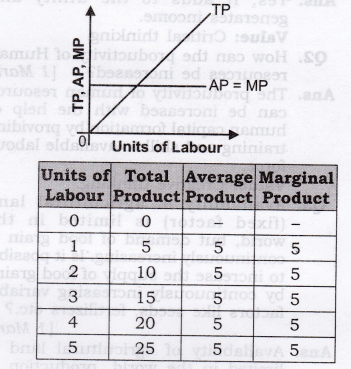
CBSE Economics For class 12



0 Comments
Please Comment